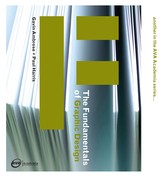
Job No:01077 Title:The fundamentals og Graphic Design
2ND
Proof Page:14
Aesthetics
Of or concerning the appreciation of beauty or good taste.
Deconstruction
A method of critical enquiry that examines how meaning is constructed by challenging prescribed values which are presented to
us. For example, why should folio numbers be small and in the corner of a page?
Executing the job
The designer’s next task is to execute the job.
Designers may work with, and choose from, a varied
selection of sources to conceive the final design –
whether employing a philosophical viewpoint, such
as modernism, or relying on pure aesthetics, such
as current trends in typeface design or fashion.
A valuable part of the design process is the final
resolve, look and feel (a
esthetic qualities) of the
project. Aesthetic control is more far-reaching than
selecting sizes and colours as it brings order to a
project, and aids communication and understanding.
The implementation of a clear hierarchy can both
enrich and simplify a project by making it easier for
the user to locate and obtain information – whether
the job is a complex signage system or a simple
restaurant menu.
Fulfilling the brief
The first task a graphic designer fulfils is to work
out what has to be done in order to satisfy a design
brief (see page 74). This may involve conducting
research into the subject matter in order to generate
preliminary ideas. Any project begins as a series of
preliminary sketches, thoughts or ideas.
A graphic designer brings a sense of order to
these concepts and arranges them in a way that
gives them pace and meaning. In essence, a designer
creatively structures and edits the job, and makes
decisions regarding what is vital to communicate
and how best to convey the message.
14 The Fundamentals of Graphic Design Graphic design as a discipline
What is a graphic designer?
Thinking of graphic design as a trade is
anachronistic and limited. It is more useful to look
at the underlying approach to design that a graphic
designer takes in order to understand his or her role
in the print and digital production process. A designer
essentially has two roles in the process: satisfying the
design brief and executing the job.
001-023 01077_C1.qxd 8/20/08 9:29 AM Page 14

Job No:01077 Title:The fundamentals og Graphic Design
2ND
Proof Page:15
Communicating and conveying messages
A designer can arrange text and images in an
infinite number of ways, but the ultimate aim is to
communicate effectively rather than produce
avant-garde work for its own sake. Design actively
develops, maintains and evolves conventions, axioms
and clichés in order to convey important messages.
For instance, why does the front page of a newspaper
contain 500 words and one large picture, a masthead
and a standfirst? Because this format has become
the convention accepted by readers and anything
drastically different may prevent them from buying
or reading a newspaper.
Conventions save designers from having to start
from scratch with every job. However, this is not to
say that there is no room for innovation. On the
contrary, innovation tends to occur within the bounds
of established convention. Design conventions are a
useful and necessary element of society. For example,
motorway signs function according to conventions as
they communicate messages that can be instantly
processed by motorists. If signs did not communicate
effectively, there would be more accidents.
On the other hand, the d
econstruction method
of critical enquiry examines how meaning is
constructed by challenging the prescribed values
presented to us. The term ‘deconstruction’ was
coined by French philosopher Jacques Derrida in
the 1960s to describe a viewpoint that looks at how
meaning is constructed. By challenging or
deconstructing accepted values, meaning can be
delivered in different ways. For example, why should
folio numbers be small and located at the corner of
a page? Why can’t they be large and in the centre
of a page?
What is graphic design? < What is a graphic designer? > Group structures and working methods 15
For Reading Out Loud
This spread is from For
Reading Out Loud, a collection
of poems by Mayakovsky
(1893–1930). It was designed
by the constructivist El
Lissitzky (1890–1941) and
published in Berlin in 1923.
The role of the graphic
designer involves interpreting
a brief and producing a design
using skills that blur
the boundaries between
artist, designer, typographer
and philosopher.
001-023 01077_C1.qxd 8/20/08 9:30 AM Page 15
..................Content has been hidden....................
You can't read the all page of ebook, please click here login for view all page.
